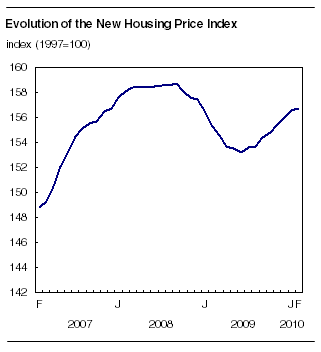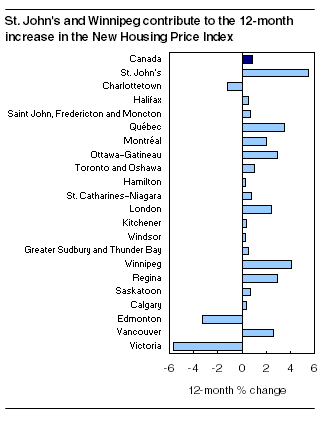Common menu bar links
New Housing Price Index
Archived Content
Information identified as archived is provided for reference, research or recordkeeping purposes. It is not subject to the Government of Canada Web Standards and has not been altered or updated since it was archived. Please "contact us" to request a format other than those available.
Related subjects
The New Housing Price Index (NHPI) rose 0.1% in February following a 0.4% increase in January.

Between January and February, prices rose in 14 of the 21 metropolitan areas. Prices increased the most in Regina (+2.0%), followed by Winnipeg and London (both up 1.9%).
In Regina, prices rose as some builders reported higher materials costs as well as increased lot prices from developers. Other builders increased their lot prices after having re-evaluated the value of their land.
In Winnipeg, the increase in prices was primarily attributed to builders moving to new phases of development with increased land development costs. In London, builders reported higher operating costs.
Toronto and Oshawa (-0.7%) as well as Charlottetown (-0.5%) were the only metropolitan areas to register monthly decreases in February.
In Toronto and Oshawa, although a number of builders reported increased prices due to strong market conditions and new list prices, the index has dropped as a result of the introduction of the Harmonized Sales Tax and the treatment of value added taxes in the calculation of the NHPI.
In Charlottetown, builders lowered their prices to remain competitive.
Year over year, the NHPI was up 0.9% in February following a 0.1% increase in January. This was the second consecutive year-over-year increase recorded since December 2008.

The largest year-over-year increase was recorded in St. John's (+5.5%) followed by Winnipeg (+4.1%) and Québec (+3.5%). Higher residential land values were the primary reason for the increases in all three metropolitan areas.
Compared with February 2009, contractors' selling prices were also higher in Ottawa–Gatineau, Regina and London.
For the first time since 2008, year-over-year increases were posted in Vancouver (+2.6%) and Calgary (+0.4%).
Only three metropolitan regions registered 12-month declines in February; Victoria (-5.7%), Edmonton (-3.3%) and Charlottetown (-1.2%).
Note: The New Housing Price Index (NHPI) measures changes over time in the selling prices of new residential houses agreed upon between the contractor and the buyer at the time of the signing of the contract. It is designed to measure the changes in the selling prices of new houses where detailed specifications pertaining to each house remain the same between two consecutive periods. The prices collected from builders and included in the index are market selling prices less value added taxes.
As of July 1, 2010, the Harmonized Sales Tax (HST) will come into effect in Ontario and British Columbia. According to the Canada Revenue Agency "[if] the written agreement of purchase and sale is entered into after June 18, 2009 (November 18, 2009, in British Columbia), and both ownership and possession of the house transfer to the purchaser after June 2010, the HST at 13% (12% in British Columbia) would apply to the sale." Some builders in Ontario are already including the HST in the prices of some of their new houses. The impact of the HST is reflected in some of the metropolitan areas NHPI's in this province in February 2010. Builders in British Columbia have not yet reported the inclusion of the HST on the prices of their new houses.
This release presents data that are not seasonally adjusted and the indexes published are final.
Available on CANSIM: table 327-0005.
Definitions, data sources and methods: survey number 2310.
The fourth quarter 2009 issue of Capital Expenditure Price Statistics (62-007-X, free) will be available soon.
The new housing price indexes for March will be released on May 12.
For more information, or to enquire about the concepts, methods or data quality of this release, contact Client Services (613-951-4550; toll-free 1-888-951-4550; fax: 613-951-3117; (ppd-info-dpp@statcan.gc.ca), Producer Prices Division.
Table 1
| 2010 | February 2009 | January 2010 | February 2010 | January to February 2010 | February 2009 to February 2010 | |
|---|---|---|---|---|---|---|
| Relative Importance1 | 1997=100 | % change | ||||
| Canada total | 100.00 | 155.3 | 156.6 | 156.7 | 0.1 | 0.9 |
| House only | ... | 163.1 | 165.8 | 166.1 | 0.2 | 1.8 |
| Land only | ... | 139.4 | 137.9 | 137.7 | -0.1 | -1.2 |
| St. John's | 1.20 | 179.0 | 188.9 | 188.9 | 0.0 | 5.5 |
| Charlottetown | 0.31 | 121.0 | 120.2 | 119.6 | -0.5 | -1.2 |
| Halifax | 1.22 | 150.5 | 151.3 | 151.3 | 0.0 | 0.5 |
| Saint John, Fredericton and Moncton2 | 0.88 | 120.3 | 120.9 | 121.1 | 0.2 | 0.7 |
| Québec | 2.46 | 164.6 | 170.4 | 170.4 | 0.0 | 3.5 |
| Montréal | 10.11 | 164.4 | 167.2 | 167.7 | 0.3 | 2.0 |
| Ottawa–Gatineau | 4.71 | 169.6 | 173.5 | 174.6 | 0.6 | 2.9 |
| Toronto and Oshawa2 | 33.99 | 146.4 | 148.9 | 147.8 | -0.7 | 1.0 |
| Hamilton | 2.96 | 152.2 | 151.3 | 152.7 | 0.9 | 0.3 |
| St. Catharines–Niagara | 0.96 | 155.9 | 156.8 | 157.2 | 0.3 | 0.8 |
| London | 1.91 | 144.4 | 145.1 | 147.9 | 1.9 | 2.4 |
| Kitchener | 2.17 | 143.2 | 143.7 | 143.8 | 0.1 | 0.4 |
| Windsor | 0.65 | 103.7 | 104.0 | 104.0 | 0.0 | 0.3 |
| Greater Sudbury and Thunder Bay2 | 0.85 | 112.7 | 113.0 | 113.3 | 0.3 | 0.5 |
| Winnipeg | 1.62 | 181.4 | 185.3 | 188.8 | 1.9 | 4.1 |
| Regina | 0.59 | 250.9 | 253.1 | 258.1 | 2.0 | 2.9 |
| Saskatoon | 0.81 | 215.2 | 214.8 | 216.6 | 0.8 | 0.7 |
| Calgary | 7.88 | 233.6 | 234.4 | 234.6 | 0.1 | 0.4 |
| Edmonton | 8.29 | 215.7 | 207.9 | 208.6 | 0.3 | -3.3 |
| Vancouver | 14.39 | 116.2 | 118.5 | 119.2 | 0.6 | 2.6 |
| Victoria | 2.04 | 112.4 | 106.0 | 106.0 | 0.0 | -5.7 |

